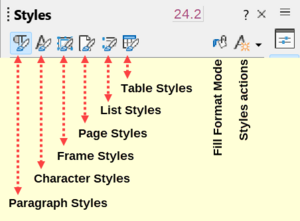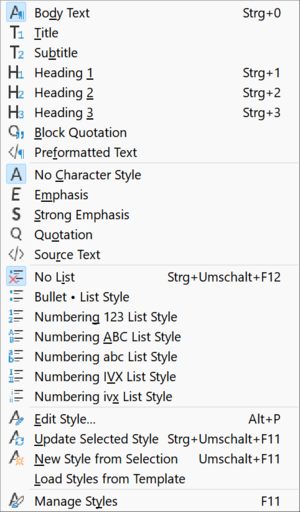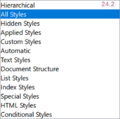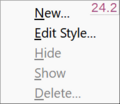Styles in Writer
TDF LibreOffice Document Liberation Project Community Blogs Weblate Nextcloud Redmine Ask LibreOffice Donate
Foreword
The Video "Styles in Writer - LibreOffice" links to this page here, which offers further information and details.
Link to the Video
The order in the video is slightly different.
Link to the Video:
Styles in Writer - LibreOffice
What are the advantages of styles?
When using styles, we talk about indirect or "soft" formatting.
This means that you don't apply the formatting to the text, but define it in the styles and then apply it to the text.
In a style/paragraph style you can adjust several properties for your needs at the same time.
For example, font, font size, font color, and much more. It is a whole package of properties.
With the help of format styles, the protocol is quickly put into the best possible form and you thus receive good-looking documents.
If you apply styles to all paragraphs, they will inherit the properties defined in the paragraph style.
Now, at a later time, you remember that you want to change the text color.
Then you change the text color in the assigned paragraph style and all paragraphs immediately adopt the new color.

Where can I find the styles?
The Sidebar
All styles can be found in the sidebar, which can be turned on or off via ▸ menu or Ctrl + F5.
Here you can find the
- Paragraph styles
- Character styles
- Frame styles
- Page styles
- List styles
- Table Styles
-
Sidebar Paragraph Styles
-
Sidebar Character Styles
-
Sidebar Frame Styles
-
Sidebar Page Styles
-
Sidebar List Styles
-
Sidebar Table Styles
-
Sidebar Filter Paragraph Styles
-
Sidebar Filter Charcter Styles
-
Sidebar Filter Other Styles
-
Sidebar Styles Contextmenu
The Menu "Styles"
Here you can choose one from a selection of important styles to assign from the menu.

The "Formatting" toolbar
The paragraph style of the paragraph in which the cursor is located is displayed in the "Formatting" toolbar.
"Body Text" means that the text has the "Body Text" style.
However, the display of Style here depends on the position of the cursor and which Style was used at this position.

| 1 Set Paragraph Style | 2 Update Selected Style | 3 New Style from Selection | 4 Font Name |
| 5 Font Size | 6 Bold | 7 Italic | 8 Underline |
| 9 Strikethrough | 10 Superscript | 11 Subscript | 12 Clear Direct Formatting |
| 13 Font Colour | 14 Character Highlighting Colour | 15 Align Left | 16 Align Centre |
| 17 Align Right | 18 Justified | 19 Toggle Unordered List | 20 Toggle Ordered List |
| 21 Select Outline Format | 22 Increase Indent | 23 Decrease Indent | 24 Set Line Spacing |
| 25 Increase Paragraph Spacing | 26 Decrease Paragraph Spacing |
Styles - Built-in and Custom
All Styles can be found in the Sidebar.
If the Sidebar is not available, select ▸ ( Ctrl + F5 ) from the menu.
An open Writer document always has at least one Style/Paragraph style associated with it.
Styles - Built-in
Once you have installed LibreOffice correctly, you will find the Styles in the open Writer document.
You can find them in the Sidebar.
You can customize the properties of Built-in Styles.
However, you cannot rename or delete these Styles.
However, you can hide most of these Styles.
Styles - user defined
You can create your own user-defined Styles or derive them from existing Styles.
Right-click on an existing Style, for example "Default Paragraph Style" or "Body Text" and choose .
Then click the "Organiser" tab and enter a name for the new Style.
Change the properties (for example Font size and color) that you want to assign to the text.
Then click .
The Paragraph Style tabs:
-
Alignment
-
Area
-
Borders
-
Drop Caps
-
Font
-
Font Effects
-
Highlighting
-
Indents&Spacing
-
Organiser
-
Outline&List
-
Position
-
Tabs
-
Text Flow
-
Transparency
Assign a Style
Place the cursor in the text to which you want to assign the Style.
If the sidebar is not visible, open it with ( Ctrl + F5 ) and double-click on the desired Style.
Don't use the "Standard" paragraph style for your text; it is the source of all other paragraph styles.
Normally, the "Body Text" paragraph style should be used for normal text.
Exercise - Create, modify and assign styles
The Originals "Aufgabe_Formatvorlagen" and "Protokoll_Übungsdatei" in German language
come from the Author: Ellen Pape, E-Mail: ellenpape@libreoffice.org
Please refer: Writer-Übungen Teil 1, Arbeiten mit Formatvorlagen
An already written "Protocol model school" protocol is used for this task.
The protocol will be formatted with styles.
It should look better after formatting.
Abbreviations:
- P = protocol
- TC = teachers' conference
- IA = item of the agenda
Style names:
- P_Header (Protocol Header)
- P_IA (Protocol item of the agenda)
- P_Text (Protocol text)
To do this, you first create the new styles.
You change styles.
Then you assign the styles to the Text and Headings.
Open the File
You can use the existing protocol ″Protocol model school″, see Used working documents.
Now open the File.
Part 1 – create style P-Header
For the formatting of the protocol header, you will now create a new style "P-Header".
Right-click on the style "Heading". Click then on , then on tab "Organiser" and enter name P-Header.
Give the new style the properties the header should receive:
Font: Arial
Fontsize: 14 pt
Fontstyle: bold
Font colour: black
Spacing: Above paragraph 0,0 cm and Below paragraph 0,3 cm.
Click on
Part 2 – create style P-IA
Create a new style "P-IA". (right-click on ″Heading″, then on , then on tab ″Organiser″ and enter name P-IA)
In style, specify the properties to be obtained for the item of the agenda:
Font: Arial
Fontsize: 14 pt
Fontstyle: regular
Font colour: Light Blue 2
Spacing: Above paragraph 0,4 cm and Below paragraph 0,2 cm.
Then click on
Part 3 – create style P-Text
Now, starting from style "Body Text", create the "P-Text" style.
Click on "Body Text" with the right mouse button and choose , then on tab ″Organiser″ and enter name P-Text.
Give the new style the properties the text should receive:
Font: Arial
Fontsize: 11 pt
Fontstyle: regular
Fontcolour: black
Spacing: Above paragraph 0.0 cm and Below paragraph 0.2 cm.
Click on
Part 4 – modify style P-IA
The style "P-IA" should be provided with numbers:
- Right-click on the style "P-IA".
- Then select . Then in the Dialog "Paragraph Style: P_IA" choose the tab "Outline & Numbering":
For Numbering/Numbering style, select: Numbering 123.
As soon as you press , all items of the agenda change.
Part 5 - Remove all hard line breaks
Remove all hard line breaks feeds or returns, as they are unnecessary as a space between paragraphs.
Part 6 - Clear Direct Formatting
In the Menu click ▸ .
The click in the Menu ▸ or with the keys Ctrl + M.
Part 7 - Assign styles
Now, the header, the items of the agenda, and the text are each assigned the style, as follows.
Move the cursor to the header or paragraph (if the sidebar is not visible, open it with Ctrl + F5 and double-click on the desired style.
Part 7.1 – P_Header assign to the header
Mark the header.
Double-click on the style ″P_Header″.
Part 7.2 – P_IA assign to the items of the agenda
Mark each items of the agenda. Double-click on the style ″P_IA″.
Part 7.3 – P_Text assign to the text
Mark each text. Double-click on the style ″P_Text″.
Do exercises on your own
Try applying alternative values in the styles.
Especially for styles with Indents and Spacing - Spacing Above paragraph respectively Below paragraph.
Further Information
Used working documents
The working documents can be downloaded here:
- Exercise - Working with styles in Writer V6.4
- Protocol model school V6.4
- Protocol model school V6.4_Solution
- "Format styles settings"
Related topics
Professional text composition with Writer
Inheritance in paragraph styles in Writer
Document templates Letter template in Writer
Documentation / Manuals
Here you will find the Documentation / Manuals:
Any questions?
For questions on this topic go to:
Get Involved
Join us today and help us to make it even better!
Donate
LibreOffice is Free Software and is made available free of charge.
Your donation, which is purely optional, supports our worldwide community.
If you like the software, please consider a Donation.




















